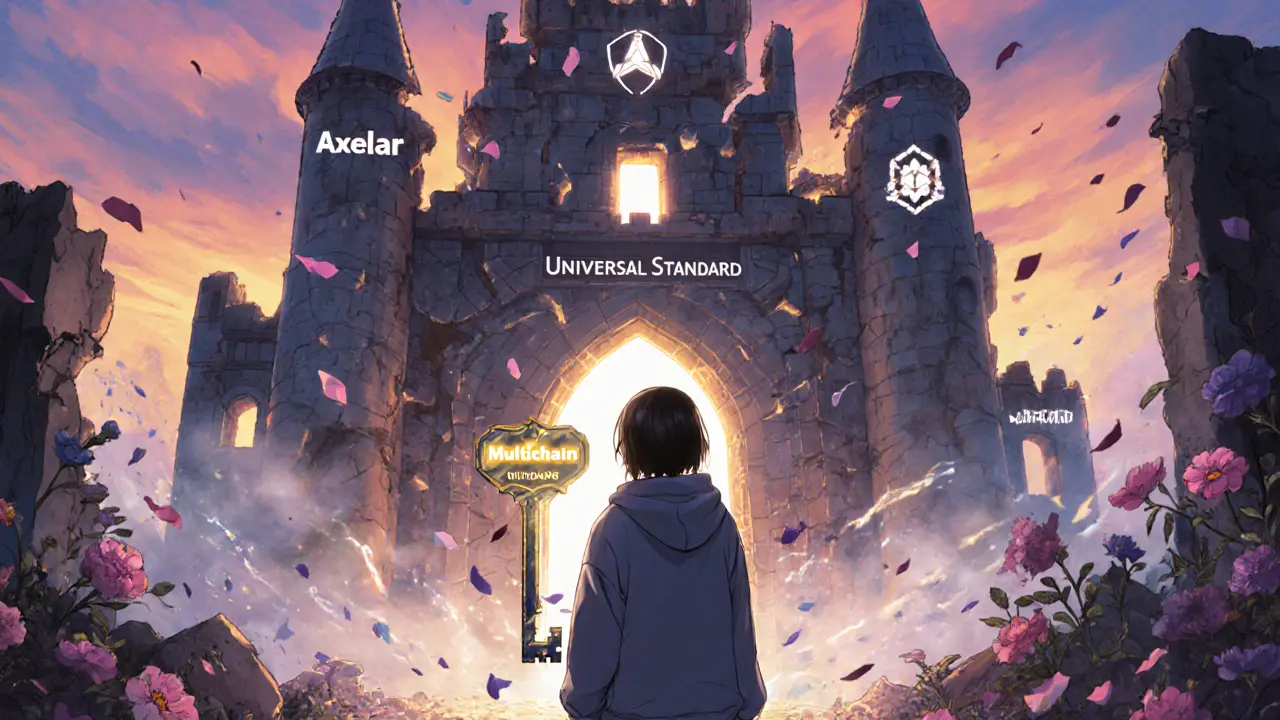Cross-Chain Transfer Cost Calculator
Source Chain
Destination Chain
Estimated Fees
+ =
Estimated Time
Security Risk
Imagine sending money from Ethereum to Solana like you’d send a text message-fast, cheap, and seamless. That’s the promise of cross-chain technology. But in 2025, it’s not that simple. While cross-chain bridges moved over $32 trillion in transaction volume last year, they also became the number one tool for laundering illicit crypto. Over $21.8 billion in illegal funds passed through them in 2025 alone. The tech works brilliantly for users who want to jump between chains-but it’s a nightmare for regulators, security teams, and even everyday people trying to send $150 from Ethereum to Polygon.
Why Cross-Chain Bridges Are Broken
Cross-chain bridges are the plumbing of modern blockchain. They let you move assets like USDC, ETH, or SOL between networks that don’t natively talk to each other. But most of them are built like rickety wooden footbridges over a canyon-functional, but dangerous under pressure.Over 50% of these bridges struggle with scalability. During spikes in activity-like when a new DeFi token launches or a major NFT drop happens-transactions slow to a crawl. One user on Reddit reported a $150 transfer from Ethereum to Polygon took 47 minutes and three failed attempts. Gas fees for that one transfer hit $28.73. That’s not interoperability. That’s a tax on convenience.
Only 25% of bridges support stablecoins reliably. That means if you want to move DAI or USDT, you’re stuck with limited options, high fees, or no support at all. And when a bridge fails, there’s often no customer service. Trustpilot reviews for major cross-chain services average just 2.8 out of 5 stars, with 63% of complaints about unexpected transaction failures and 58% about no support when things go wrong.
The Security Nightmare
Cross-chain bridges are the most targeted part of the entire crypto ecosystem. According to Stanford’s Dr. Wei Wang, who analyzed 37 major bridge exploits between 2020 and 2024, they’re the weakest link. Why? Because they’re centralized points of failure disguised as decentralized systems.The Wormhole bridge was hacked for $320 million in 2022. The bZx exploit in 2021 saw attackers move $55 million across three chains using four different bridges to hide their trail. These aren’t theoretical risks-they’re real, repeated, and expensive.
There are two main types of bridges: trusted and trustless. Trusted bridges, like those run by centralized exchanges (Binance, Coinbase), are more secure because they’re backed by companies with legal accountability. But they defeat the whole point of decentralization. Trustless bridges, like those using Hashed TimeLock Contracts, are more “crypto-native”-but they’re harder to build, easier to exploit, and often lack audits. The trade-off is brutal: security vs. freedom.
And then there’s the problem of transparency. When funds move from Ethereum to Binance Smart Chain, most blockchain analytics tools lose the trail. Merkle Science found that investigators can’t trace the full path of a transaction across chains. The destination address is invisible. The route is opaque. For law enforcement, it’s like chasing a ghost.

Regulation Can’t Keep Up
Regulators are playing catch-up. The European Union’s MiCA 2.0 framework, expected by Q3 2025, might be the first major attempt to force cross-chain transparency. But until then, compliance is a mess.KYC-Chain found that over $600 million in illicit activity in 2024 came from individual vendor shops operating across multiple blockchains-bypassing centralized darknet markets entirely. Traditional AML systems, built to flag blacklisted wallet addresses, are useless here. A criminal doesn’t need to use a known bad address. They just need to move $5,000 across five chains, each time changing wallets. No single chain sees the full picture.
Enterprises are stuck. According to Gartner, only 18% of Fortune 500 companies have adopted cross-chain tech-not because they don’t want to, but because they can’t navigate the regulatory gray zone. GDPR and CCPA compliance becomes impossible when data flows across chains with no clear jurisdiction. One enterprise blockchain lead told CoinLaw: “We can’t sign off on a system where we don’t know where the data ends up.”
The Fragmentation Problem
There are over 127 cross-chain protocols in 2025. Only five-Axelar, LayerZero, Chainlink CCIP, Wormhole, and Multichain-control 68% of the total value locked (TVL). That’s not competition. That’s a fragile oligopoly.Every protocol uses different standards. Some use message-passing. Others rely on oracles or federated validators. There’s no universal protocol. As a result, 80% of blockchain projects struggle to integrate cross-chain features. It takes 3 to 6 months of engineering work just to plug into one bridge. And even then, key management across chains is a headache for 78% of developers.
Documentation varies wildly. Wormhole’s docs have a 3.2/5 rating on GitHub. Axelar’s? 4.5/5. That gap isn’t about features-it’s about usability. Smaller teams can’t afford to spend months deciphering bad documentation. They just give up.

Who’s Winning-and Who’s Falling Behind
Axelar is the standout. In the past year, it saw a 536% surge in interchain transactions and a 492% growth in active addresses. Why? Better security, cleaner docs, and a focus on developer experience. One user moved $2.3 million across five chains with only 0.87% slippage and zero failures.Wormhole, once a leader, is still recovering from its $320 million hack. Its reputation took a hit, and developers are moving to alternatives. Multichain, which suffered a $600 million exploit in 2023, now has 40% less TVL than it did two years ago.
Meanwhile, centralized exchanges like Binance and Coinbase are quietly dominating. They offer built-in cross-chain swaps with no need for external bridges. But that comes at a cost: you’re trusting a single company with your assets. It’s not DeFi anymore-it’s just banking with crypto labels.
The Future Is Unclear
The path forward isn’t obvious. Forrester predicts only 15 to 20 cross-chain protocols will survive by 2027. Gartner warns that without global standards, fragmentation could cripple enterprise adoption by 2028.On the positive side, tools like Elliptic’s new cross-chain screening platform can now trace illicit flows in minutes instead of hours. KYC-Chain’s 2025 AML tracing solution tracks over 50 blockchains. That’s progress.
But the biggest hurdle isn’t technical-it’s political. No country wants to give up control over its financial data. The U.S., EU, and China all have different rules. Until there’s a global agreement on how to monitor cross-chain flows, the system will remain a patchwork of risks.
For now, cross-chain tech is like a supercar with no brakes. It’s fast, powerful, and exciting. But if you don’t know how to stop it-or worse, if someone else is driving-it’s a disaster waiting to happen.
What are the biggest security risks with cross-chain bridges?
The biggest risks come from centralized points of control. Even so-called "trustless" bridges often rely on a small group of validators or oracles. If those are compromised, attackers can drain funds across multiple chains. Major hacks like Wormhole’s $320 million exploit and bZx’s $55 million multi-chain theft show how easily funds can be moved and hidden. Most bridges also lack real-time audit trails, making it hard to detect attacks before it’s too late.
Why do cross-chain transfers take so long and cost so much?
Many bridges are overloaded during peak usage. When Ethereum gas prices spike, bridges that rely on it as a base chain slow down. Some bridges require multiple confirmations across different networks, adding delay. Fees are high because users are paying for gas on both the source and destination chains, plus bridge operator fees. Stablecoin transfers are especially expensive because they’re in high demand but poorly supported by only 25% of bridges.
Can regulators actually track cross-chain transactions?
Traditionally, no. Most blockchain analytics tools only track activity within a single chain. When funds move from Ethereum to Solana via a bridge, the trail often disappears. But new tools like Elliptic’s cross-chain screening and KYC-Chain’s 2025 AML tracer can now follow funds across 50+ chains. These tools use behavioral analysis and entity resolution to connect wallets that appear unrelated. They’re not perfect, but they’ve reduced investigation times from hours to minutes.
Are centralized exchanges safer than decentralized bridges?
For most users, yes. Exchanges like Binance and Coinbase handle cross-chain swaps internally. They’re regulated, have customer support, and can reverse errors. But you’re giving up control-you don’t hold your private keys. Decentralized bridges give you full ownership, but if something goes wrong, there’s no refund. If you’re moving $10,000 or more, the trade-off matters. For small amounts, centralized swaps are simpler. For large or frequent transfers, you need to understand the risks.
What’s the future of cross-chain technology?
The future depends on standardization. Right now, every bridge is its own walled garden. If the industry settles on a single open standard-like a universal message format or shared validator pool-adoption will explode. Until then, consolidation is coming. Only a handful of protocols will survive. Regulatory clarity, especially from the EU’s MiCA 2.0, will be the deciding factor. If governments demand transparency, bridges will adapt. If they don’t, cross-chain tech will remain a tool for innovators-and criminals.


Nidhi Gaur
November 17, 2025 AT 05:51rahul saha
November 18, 2025 AT 15:08Marcia Birgen
November 20, 2025 AT 10:31Jerrad Kyle
November 21, 2025 AT 17:15